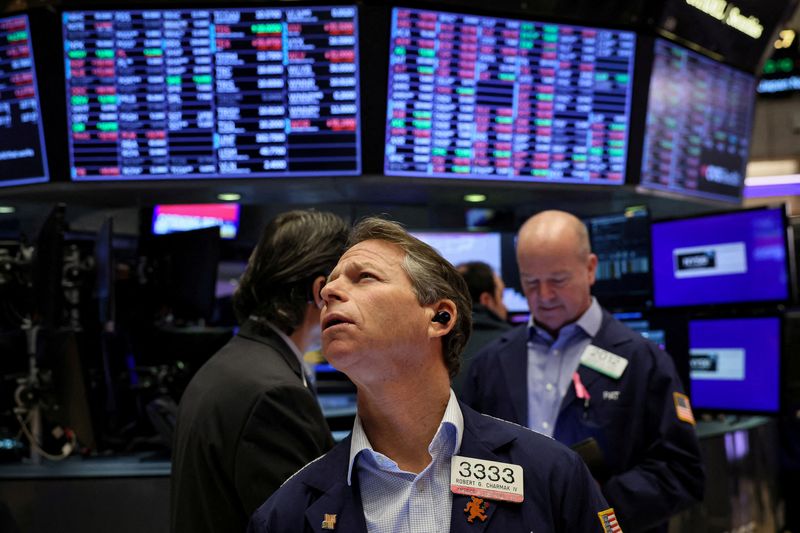
©Reuters. FILE PHOTO: Traders work at the New York Stock Exchange (NYSE) in New York City, U.S., January 9, 2024. REUTERS/Brendan McDermid/File Photo
By Mike Dolan
LONDON (Reuters) – Record highs, high valuations, tight markets, frenetic tech bandwagons and even viable alternatives in bonds – all sure to gnaw at U.S. household savers looking to offload stocks.
Yet, not even a little.
In some strange play of long-term momentum, U.S. families lucky enough to have substantial savings are finding themselves trapped in stocks like never before.
JPMorgan long-term strategists Jan Loeys and Alexander Wise unmask what they have dubbed America’s “love affair” with stocks and show how the share of stocks held by families and nonprofit funds, such as university endowments, has quadrupled in 40 years to reach record levels. levels above 40%.
While this may seem like a modest share of total savings, it has actually grown steadily since a low of around 10% in the 1980s, far exceeds equivalent stock holdings in other large countries, and appears at odds with aging of the population who might reasonably be willing to make “zero-risk” investments towards retirement.
The equity-equivalent share of Japanese and German household savings, for example, is only 13% and 16% respectively, while in France it is around 26%, the JPMorgan team estimates. And, more precisely, these have not increased at all in about 30-40 years.
Despite all the whys and wherefores of this behavior, one of the main reasons revolves around inertia, a certain satisfaction and quite a bit of hope for the future.
Using data from the Federal Reserve’s U.S. Financial Accounts Report, Loeys and Wise hypothesize that the forty-year increase in the share of stock capital in household savings may simply be due to the passive outperformance of stocks over that period.
In other words, savers simply stood still instead of actively chasing the markets anyway.
‘FOLLOW THE FLOW’
Unlike professional fund managers, who tend to “reset the meaning” or maintain target weightings by selling when an asset class’s outperformance inflates the relative share of holdings in portfolios, families closed their eyes and crossed their fingers.
For the last 40 years at least, it’s hard to argue with it as a strategy.
“One possibility, contrary to how we all like to think about strategic asset allocation, is that end investors may not have a strong, or even vague, view on how much they want to allocate across different asset classes and simply go with the flow,” JPMorgan strategists wrote.
Given that US stocks have gained nearly 11% annually over the past 35 years – more than double the annual return of bonds – simply combining those returns over the period without cuts and changes would have led to that steady quadrupling of the equity share of their investments. .
That’s not to say it’s necessarily indifference, but more of an extrapolation of past performance and confidence that it can continue. And in a vicious cycle, the very confidence in holding ever-larger stocks has driven at least half of the outperformance of US stocks relative to the rest of the world, while the rest has hindered faster earnings growth.
There are of course other reasons: low economic volatility and low interest rates over those decades encouraged greater risk-taking, and the growth of cheaper passive investment vehicles and direct stock purchase tools attracted many to the sector equity.
Furthermore, Loeys and Wise believe we may have reached a high point that will lead to a change in behavior as macro volatility increases over the next decade, higher yields make bonds more attractive, and an aging population will eventually require at least one part of the risk is eliminated from the market. table.
However, don’t hold your breath.
They conclude: “The move toward lower equity allocations by U.S. households and nonprofits is not imminent as return expectations are likely still quite bullish and households are not changing allocations as quickly.”
DAMAGE TO YOUR WEALTH
That said, the fear of an overvalued stock market at historic highs certainly creates a certain amount of nervousness.
After all, indexes have more or less doubled from pre-pandemic levels and forward price/earnings multiples, while below historical peaks, are 20%-30% above long-term averages.
Is it time to lighten up?
Hold your horses, says Duncan Lamont, head of strategic research at Schröder (LON:).
With an in-depth analysis of 100 years of market returns, Lamont calculated that cashing in stocks at record levels – where they have been at nearly a third of the 1,176 months since 1926 – would be very costly over time.
Average inflation-adjusted stock returns in the 12 months following new records are higher than in any other month: 10.3% versus 8.6%. And this adds up over the long haul.
In other words, $100 invested in U.S. stocks in 1926 would be worth $85,000 adjusted for inflation at the end of last year: annual growth of 7.1%.
However, liquidating the shares in the month they hit a new record and only returning them when they no longer did would have meant the final figure would have been just $8,780, about 90% less, a “real” return. annual rate of 4.7%.
“It’s normal to feel nervous about investing when the stock market is at an all-time high, but history suggests that giving in to that feeling would have been very damaging to your wealth,” Lamont concluded. “There may be valid reasons why you don’t like stocks, but the market at all-time highs shouldn’t be one of them.”
The opinions expressed here are those of the author, a Reuters columnist.